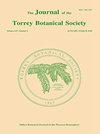刺荆花的腺点。(豆科):分布、结构及超微结构
IF 0.8
4区 生物学
Q4 PLANT SCIENCES
Journal of the Torrey Botanical Society
Pub Date : 2007-01-01
DOI:10.3159/1095-5674(2007)134[135:GDOCEL]2.0.CO;2
引用次数: 1
摘要
TEIXEIRA, S. P.(圣保罗大学(USP),里贝赫本文章由计算机程序翻译,如有差异,请以英文原文为准。
Glandular dots of Caesalpinia echinata Lam. (Leguminosae): distribution, structure and ultrastructure1
TEIXEIRA, S. P. (Departamento de Ciências Farmacêuticas, Faculdade de Ciências Farmacêuticas de Ribeiráo Preto, Universidade de São Paulo (USP), Ribeirão Preto, SP. 14040-903, Brasil) AND S. R. MACHADO (Departamento de Botânica, Instituto de Biociências, Universidade Estadual Paulista (UNESP), Botucatu, SP, 18618-000 Brasil). Glandular dots of Caesalpinia echinata Lam. (Leguminosae): distribution, structure and ultrastructure. J. Torrey Bot. Soc. 134: 135–143. 2007.—The structure and ultrastructure of immature to fully mature glandular dots in the leaf, floral organs and fruit, and their secretion components were described in Caesalpinia echinata Lam. (Leguminosae) for the first time. Data showed that glandular dots were groups of idioblasts with contents that reacted positively for both lipophilic and hydrophilic substances. Idioblasts originated from successive divisions of the ground meristem cells or mesophyll cells of an ovary of a fertilized flower. Following division, cells enlarged, the cytoplasm became denser and its content became full. No idioblasts were observed after fruit sclerification. Besides these mixed-content idioblasts, some cells in the sepals, petals and mesocarp were found to contain phenolic compounds, which probably represent a kind of constitutive defense mechanism, once the flowers and fruits become highly fitness-valued parts of the plant and can be commonly attacked. The contents of the idioblasts are released as the growth rate of the embryo increases, indicating that the plant probably diverts the precursors of secondary metabolites into the primary metabolism, at this critical time of embryo development.
求助全文
通过发布文献求助,成功后即可免费获取论文全文。
去求助
来源期刊
CiteScore
0.70
自引率
0.00%
发文量
16
审稿时长
>12 weeks
期刊介绍:
The Journal of the Torrey Botanical Society (until 1997 the Bulletin of the Torrey Botanical Club), the oldest botanical journal in the Americas, has as its primary goal the dissemination of scientific knowledge about plants (including thallopyhtes and fungi). It publishes basic research in all areas of plant biology, except horticulture, with an emphasis on research done in, and about plants of, the Western Hemisphere.

 求助内容:
求助内容: 应助结果提醒方式:
应助结果提醒方式:


